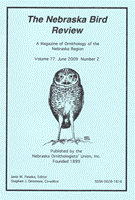Nebraska Ornithologists' Union

Nebraska Bird Review
Date of this Version
6-2019
Document Type
Article
Citation
The Nebraska Bird Review, Vol. 87 No. 2 (2019), pp 42-61
Abstract
There were many significant reports, including high and low numbers, early and late dates, out-of-range sightings including nesting, and, of course, rarities. High numbers were led by geese; an amazing 1.7 million Snows were estimated by acreage (!) and counts of 10,000 Greater White-fronted and 100,000 Canada Geese were near-record high counts for spring. A bit surprising as record spring counts were 3000 European Starlings and 3000 American White Pelicans. Nightjar surveys by Nebraska Game and Parks Commission and others yielded an amazing 40+ Chuck-will’s-widows in the southeast; Ruddy Turnstones put on a show with 85 in Platte Co; 127 Pied-billed Grebes were at Holmes Lake, Lancaster Co; Dundy Co yielded 22 Yellow-breasted Chats and 136 Orchard Orioles; a record spring total of 29 Louisiana Waterthrushes were reported; and there were no fewer than eight Snowy Plovers found in the Rainwater Basin. On the other hand, Gray Partridge and Northern Saw-whet Owl are both apparently at cyclical lows. Pinyon Jay continues to be invisibly enigmatic, and Bluewinged Warbler also seems to be disappearing from the state, as might be Black-billed Cuckoo. Encouragingly, however, Black-billed Magpie persists in Madison Co. The lack of Prothonotary Warbler reports is perhaps easily explained by devastating flooding of its Missouri River habitat. As might be expected in certain years, winter visitors in cyclical low numbers included Townsend’s Solitaire, Common Redpoll, Red Crossbill, and Snow Bunting. There were several startlingly early arrival dates, a continuing trend in recent years. These included the state’s first two March records of Sora, Ruddy Turnstone record early by 17 days, White-faced Ibis by 10 days, Olive-sided Flycatcher by 7 days, and Baltimore Orioles (banded, no less) by around two weeks. While state-level rarities are fun, probably more significant biologically are out-of-range sightings within the state. Eastern species west were the 6th Panhandle Green Heron, Sedge Wren in Lincoln Co, an eastern subspecies (Icteria virens virens) Yellow-breasted Chat in Garden Co, and the 9th Panhandle Nashville Warbler. Western species east were exemplified by two extraordinary records, both welldocumented: Red-naped Sapsucker in Sarpy Co and Cassin’s Vireo in Platte Co. Less spectacular were numerous Cinnamon Teal and Black-necked Stilts eastward, and a 2nd county record of Sharp-tailed Grouse in Dixon Co. Southern birds northward were the 2nd northerly record of Red-shouldered Hawk, 4th Pileated Woodpecker north of Washington Co, and a Lesser Goldfinch in Dawes Co. Interesting nesting records were two American Avocet nests in Fillmore Co, unfortunately soon-after inundated, and the apparent establishment of American Woodcock as a breeding bird at Calamus Reservoir, Loup Co. Last but not least is a group of state-level rarities, including the 4th American Three-toed Woodpecker, 7th Black-chinned Hummingbird, 19th Painted Bunting, 6th spring Hammond’s Flycatcher (heard only), 6th and 7th spring Broad-tailed Hummingbirds, and 9th spring Surf Scoter. Two Varied Thrushes were found, and the elusive Baird’s Sparrow was recorded in Sioux Co. Tantalizing but undocumented reports continue of Common Raven: one was heard only but not recorded in Sioux Co.
Included in
Ornithology Commons, Population Biology Commons, Poultry or Avian Science Commons, Zoology Commons


Comments
Published by the Nebraska Ornithologists’ Union, Inc.